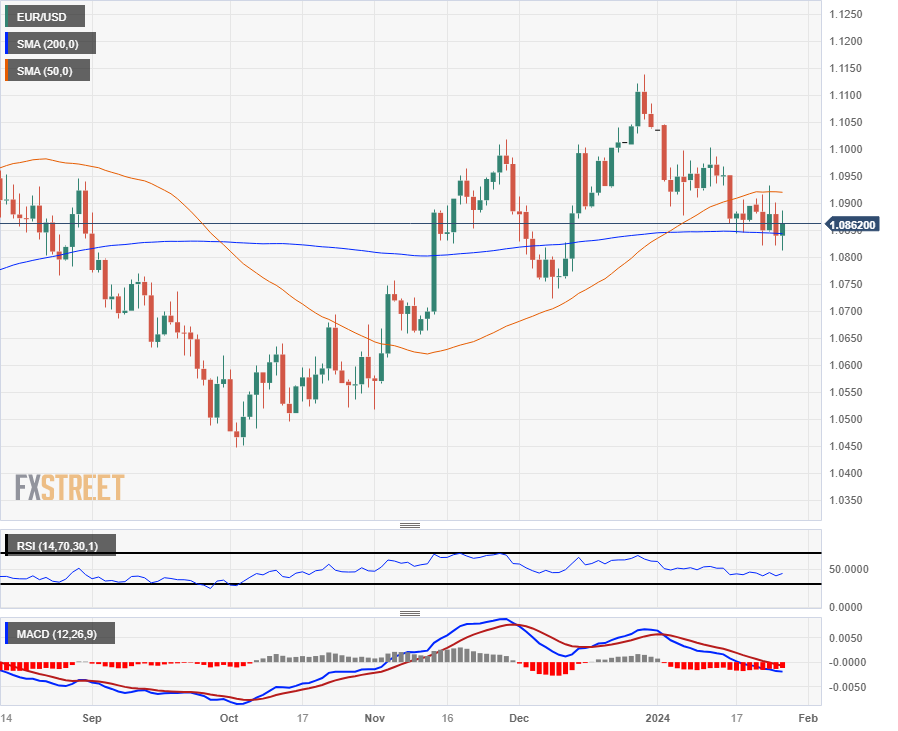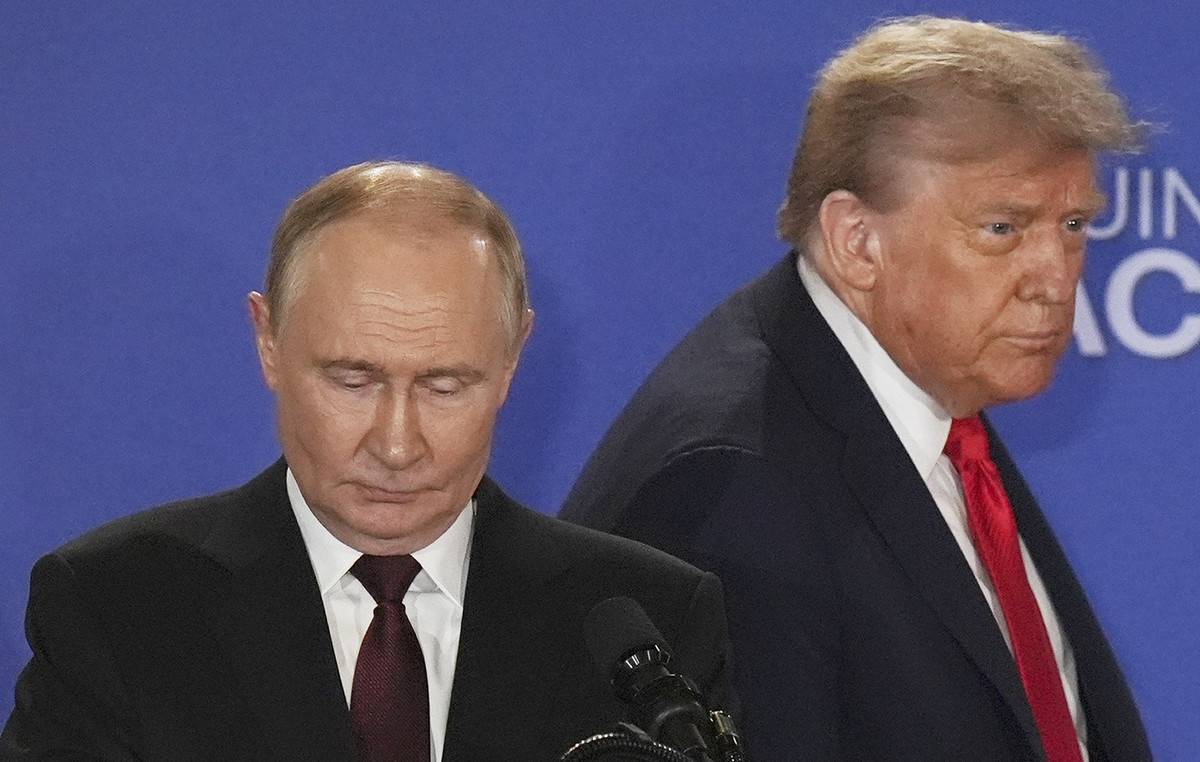- EUR/USD recovers ground near 1.0880 after falling to 1.0820.
- German consumer confidence fell to its lowest level in 11 months.
- Inflation as measured by the US PCE index fell more than expected, but spending remained high.
EUR/USD recovered recent losses on Friday, returning to familiar technical levels. However, overall gains remained limited after German consumer confidence fell to near one-year lows, as economic conditions in Europe remain tepid at best.
US Personal Consumption Price Index (PCE) inflation figures fell more than expected, but December's rise in Personal Spending along with an unexpected rebound in pending home sales reduced inflation cut expectations. rates. The U.S. economy continues to advance apace, so markets' hopes for early and deep rate cuts from the Federal Reserve continue to dim.
Daily Market Summary: EUR/USD Cuts Losses Despite Dollar's Resoluteness
- The EUR/USD fell to multi-week lows early on Friday, after German Gfk consumer confidence fell in February to its lowest level in 11 months, -29.7, against the expected improvement of -25.1 to -24.5.
- The US dollar rallied broadly after the US December year-on-year core consumer price index eased to 2.9%, down from 3.0% expected and 3.2% previously.
- Despite moderating inflation, personal spending and pending home sales rose.
- Personal spending rose 0.7% in December, compared to the 0.4% expected, and the previous month's figure was revised from 0.2% to 0.4%.
- Pending home sales in the United States rose 8.3% in December, compared to the previous month's expected rebound of 0.3% (revised downward from 0.0%), to 1.5%.
- European Gross Domestic Product (GDP) figures will be released next week on Tuesday, while the US Federal Reserve's (Fed) next high-impact interest rate meeting will take place on Wednesday.
- Eurozone fourth quarter GDP is expected to be -0.1%, in line with the previous figure, as the pan-European economy remains stagnant.
- The Federal Reserve is expected to keep rates steady in January. CME's FedWatch tool suggests markets have shifted to betting on the first rate cut in May, after bets on rates changed following the PCE release.
Euro price today
The following table shows the percentage change of the euro (EUR) against the main currencies. The Euro was the strongest currency against the Japanese yen.
| USD | EUR | GBP | CAD | AUD | JPY | NZD | CHF | |
| USD | -0.15% | -0.03% | -0.11% | 0.05% | 0.18% | 0.16% | -0.36% | |
| EUR | 0.16% | 0.13% | 0.05% | 0.20% | 0.35% | 0.33% | -0.21% | |
| GBP | 0.02% | -0.12% | -0.08% | 0.06% | 0.23% | 0.20% | -0.33% | |
| CAD | 0.11% | -0.04% | 0.07% | 0.16% | 0.29% | 0.28% | -0.25% | |
| AUD | -0.03% | -0.19% | -0.06% | -0.14% | 0.15% | 0.13% | -0.41% | |
| JPY | -0.19% | -0.35% | -0.21% | -0.31% | -0.16% | -0.02% | -0.54% | |
| NZD | -0.16% | -0.33% | -0.20% | -0.27% | -0.13% | 0.00% | -0.53% | |
| CHF | 0.34% | 0.19% | 0.31% | 0.23% | 0.37% | 0.52% | 0.51% |
The heat map shows the percentage changes of the major currencies against each other. The base currency is chosen in the left column, while the quote currency is chosen in the top row. For example, if you choose the euro in the left column and scroll down the horizontal line to the Japanese yen, the percentage change in the box will represent EUR (base)/JPY (quote).
Technical Analysis: EUR/USD hits technical barriers again, but the bullish trend is limited
EUR/USD hit a multi-week low at 1.0813 early Friday before a bounce towards the 200-hour SMA near 1.0880. Dollar bets continue to weigh on the pair, leading EUR/USD to lean towards a short-term intermediate zone around 1.0850.
Despite intraday tests to the downside, EUR/USD will continue to languish in an ongoing congestion pattern between the 50-day and 200-day SMAs at 1.0925 and 1.0850, respectively. The pair has been stuck within the consolidation pattern since falling from the December high near 1.1140.
EUR/USD Hourly Chart

EUR/USD Daily Chart
Frequently asked questions about the Euro
What is the Euro?
The Euro is the currency of the 20 countries of the European Union that belong to the euro zone. It is the second most traded currency in the world, behind the US dollar. In 2022, it accounted for 31% of all foreign exchange transactions, with an average daily volume of more than $2.2 trillion per day.
EUR/USD is the most traded currency pair in the world, accounting for an estimated 30% of all transactions, followed by EUR/JPY (4%), EUR/GBP (3%) and EUR/AUD (2% ).
What is the ECB and how does it influence the Euro?
The European Central Bank (ECB), headquartered in Frankfurt, Germany, is the reserve bank of the euro zone. The ECB sets interest rates and manages monetary policy
The ECB's main mandate is to maintain price stability, which means controlling inflation or stimulating growth. Its main instrument is to raise or lower interest rates. Relatively high interest rates – or the expectation of higher rates – tend to benefit the Euro and vice versa.
The Governing Council of the ECB takes monetary policy decisions at meetings held eight times a year. Decisions are made by the heads of the eurozone's national banks and six permanent members, including ECB President Christine Lagarde.
How do inflation data influence the value of the Euro?
Eurozone inflation data, measured by the Harmonized Index of Consumer Prices (HICP), are important econometric data for the euro. If inflation rises more than expected, especially if it exceeds the 2% target set by the ECB, it is forced to raise interest rates to bring it back under control.
Relatively high interest rates compared to their peers tend to benefit the Euro, as it makes the region more attractive as a place for global investors to park their money.
How do economic data influence the value of the Euro?
Data releases measure the health of the economy and can influence the Euro. Indicators such as GDP, manufacturing and services PMIs, employment and consumer sentiment surveys can influence the direction of the single currency.
A strong economy is good for the Euro. Not only does it attract more foreign investment, but it may encourage the ECB to raise interest rates, which will directly strengthen the Euro. Conversely, if economic data is weak, the Euro is likely to fall.
The economic data for the four largest economies in the eurozone (Germany, France, Italy and Spain) are especially significant, as they represent 75% of the eurozone economy.
How does the trade balance affect the Euro?
Another important release for the euro is the trade balance. This indicator measures the difference between what a country earns from its exports and what it spends on imports during a given period.
If a country produces highly sought-after export products, its currency will appreciate due to the additional demand created by foreign buyers wishing to purchase these goods. Therefore, a positive net trade balance strengthens a currency and vice versa for a negative balance.
Source: Fx Street
I am Joshua Winder, a senior-level journalist and editor at World Stock Market. I specialize in covering news related to the stock market and economic trends. With more than 8 years of experience in this field, I have become an expert in financial reporting.







